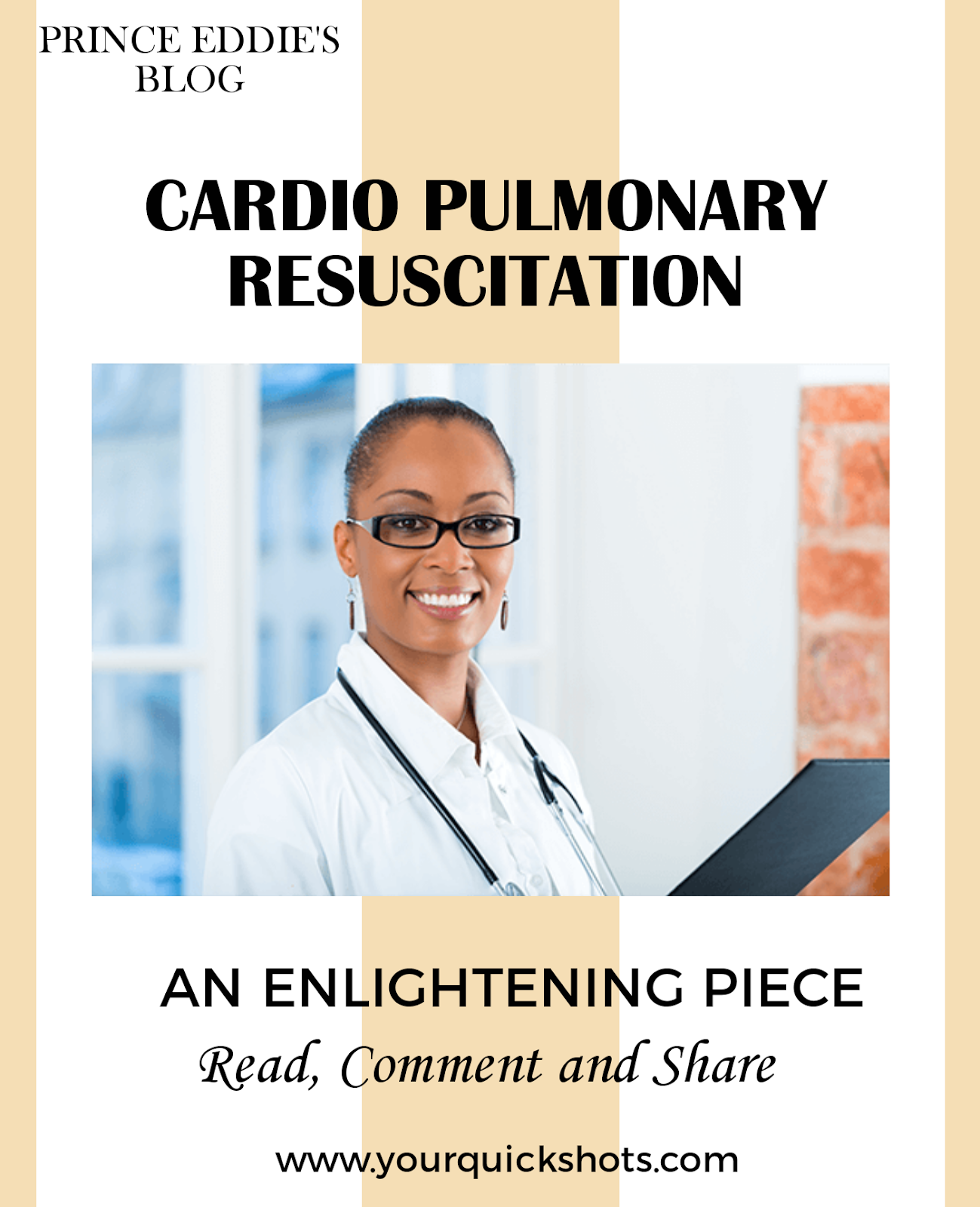CARDIO PULMONARY RESUSCITATION
INTRODUCTION
Cardiopulmonary resuscitation (CPR) is an emergency procedure consisting of chest compressions often combined with artificial ventilation in an effort to manually preserve intact brain function until further measures are taken to restore spontaneous blood circulation and breathing in a person who is in cardiac arrest.
It is recommended in those who are unresponsive with no breathing or abnormal breathing. An example is agonal respirations.
CPR involves chest compressions for adults between 5 cm (2.0 in) and 6 cm (2.4 in) deep and at a rate of at least 100 to 120 per minute.The rescuer may also provide artificial ventilation by either exhaling air into the subject's mouth or nose i.e mouth-to-mouth resuscitation or using a device that pushes air into the subject's lungs i.e mechanical ventilation.
Current recommendations place emphasis on early and high-quality chest compressions over artificial ventilation; a simplified CPR method involving only chest compressions, recommended for untrained rescuers.
OBJECTIVES/AIMS OF CPR
CPR alone is unlikely to restart the heart. Its main purpose is to restore partial flow of oxygenated blood to the brain and heart.
The objective is to delay tissue death and to extend the brief window of opportunity for a successful resuscitation without permanent brain damage.
Administration of an electric shock to the subject's heart, termed defibrillation, is usually needed in order to restore a viable and "perfusing" heart rhythm.
Defibrillation is only effective for certain heart rhythms like ventricular fibrillation or pulseless ventricular tachycardia rather than asystole or pulseless electrical activity, which usually require the treatment of underlying conditions to restore cardiac function. Early shock when appropriate is also recommended.
CPR may succeed in inducing a heart rhythm that may be shockable. It is continued until the person has a return of spontaneous circulation or is declared dead.
METHODS OF CPR
There are various methods of carrying out Cardio Pulmonary Resuscitation.
The major methods are:
- Compressions with rescue breaths
Chest compressions performed at 100 per minute on a mannequin
- Mouth-to-mouth rescue breaths
A normal CPR procedure uses chest compressions and ventilations. The compressions push on the bone that is in the middle of the chest i.e sternum and the ventilations are made pinching the victim's nose and blowing air mouth-to-mouth. If the victim is a baby, the rescuer would make the ventilations covering the baby's mouth and nose at the same time. It is recommended for all victims of any age a general compression-to-ventilation ratio of 30:2 i.e 30 rhythmic compressions before each 2 ventilations.
- Compression only
For adults with cardiac arrest, compression-only i.e hands-only or cardiocerebral resuscitation.
It's a CPR which involves chest compressions without artificial ventilation and is recommended as the method of choice for the untrained rescuer or those who are not proficient at it.
Though, compression- only method is not good for children.
- Prone CPR
It involves supine and prone positions
Standard CPR is performed with the victim in supine position. Prone CPR or reverse CPR is performed on a victim in prone position lying on the chest. This is achieved by turning the head to the side and compressing the back. Due to the head being turned, the risk of vomiting and complications caused by aspiration and pneumonia may be reduced.
- Pregnancy CPR
During pregnancy when a woman is lying on her back, the uterus may compress the inferior vena cava and thus decrease venous return. It is therefore recommended that the uterus be pushed to the woman's left. This can be done by placing a pillow or towel under her right hip so that she is on an angle of 15-30 degrees and their shoulders are flat to the ground. If this is not effective, healthcare professionals should consider emergency resuscitative hysterotomy.
- Use of devices
Devices used in carrying out CPR are:
Defibrillators
Timers for CPR
Devices used for assisting manual CPR
Devices used in giving instructions
HOW TO SURVIVE HEART ATTACK WHEN ALONE
Whenever a person has a heart attack and is at the verge of fainting, the person has about 10 seconds to lose consciousness.
If the person is alone without any assistance, these are the guidelines to be applied.
- Prolonged and vigorous coughing is necessary.
- A deep breath should be taken before each cough.
- The cough must be repeated and deep as if one is trying to produce sputum.
- The deep breath and cough must be done simultaneously every 2 seconds without let- up until help arrives or the heart begins to beat regularly.
Deep breath supplies oxygen back to the lungs while the repeated coughing contracts the muscles of the heart thereby allowing circulation of blood.
The contraction or squeezing pressure on the heart muscles helps the heart to regain its normal rhythm.
The victim can thereafter be taken to the hospital for medical treatment.
CONCLUSION
CPR is generally necessary and is to be continued in a victim of a heart attack until there is a return of spontaneous circulation or the victim declared dead.




Educative
ReplyDeleteInformative
ReplyDeleteVery brief yet so much content.
ReplyDeleteGood work��
Very educative piece
ReplyDeleteVery educative
ReplyDeleteVery educative, good work!
ReplyDeleteThanks for the update
ReplyDeleteAwesome 👍
ReplyDeleteEducative
ReplyDelete